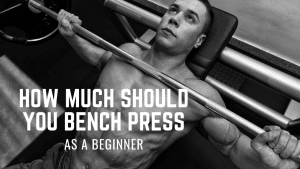What is a dumbbell chest fly and the muscles it works
The bench press may be the number one go-to exercise of people wanting to build their chest, but it is not the be-all and end-all of chest exercises. While it cannot be denied that it is truly effective and offers many benefits, the bench press is not the only chest exercise out there.
Enter the dumbbell chest fly. It may not be as popular as the bench press, but it is just as effective and beneficial. In fact, it might even be better than the good ol’ bench press because the dumbbell chest fly can stretch the pecs more since the standard bench press does not allow you to go any further than your chest.
If your interest has now been piqued, then keep scrolling to get to know the dumbbell chest fly more.
What is a dumbbell chest fly?
The dumbbell chest fly is an upper body exercise that strengthens and develops the chest by targeting all areas of the pectoralis major specifically the sternal fibers which are attached to the sternum. Working this specific area of the chest creates that defined division between the pecs.
Traditionally, the dumbbell chest fly is performed while lying flat on a bench, but other variations include doing it inclined and even while standing.
What are the muscles at work during a dumbbell chest fly?
The primary muscle at work during a dumbbell chest fly is the pectoralis major, more commonly known as the pecs, which is made up of two heads: the clavicular head which is the upper chest, and the sternal head which spans the middle to lower chest.
Both heads are engaged in a dumbbell chest fly but the angle by which you do this exercise will affect which area of the chest will be more focused on. For instance, if you do an incline dumbbell chest fly, the angle of the bench will place greater tension on the clavicular head than it would during a regular dumbbell chest fly.
Aside from the chest muscles, the shoulder muscles, scientifically known as the deltoids, also play a major role in the execution of the dumbbell chest fly. The deltoids are composed of three heads: the anterior head at the front, lateral head on the side, and posterior head at the back.
Just like the chest muscles, all heads of the deltoids are engaged in a dumbbell chest fly but more tension is placed on the anterior deltoids when this exercise is performed on an incline bench.
Your biceps are also at work in a dumbbell chest fly, although to a much lesser degree than the chest and shoulder muscles. Since your arms need to be slightly bent during this exercise, you need to recruit the biceps to stabilize your arms throughout the movement.
How to do the dumbbell chest fly
1. Begin by sitting on a bench and picking up a pair of dumbbells off the floor. Hold them with a neutral grip then place each end of the dumbbell in your hip crease.
2. To go into the starting position, lie down with your back flat on the bench and put the dumbbells close to your chest. Once you are all set, inhale then press the dumbbells and lock them out at the top.
3. Retract your shoulders then unlock your elbows and open your arms to lower the dumbbells on both sides of your body while keeping your elbows slightly bent.
4. Once the dumbbells are at chest level, squeeze your pecs then bring the dumbbells back up to return to the starting position without letting them touch.
5. Repeat according to your desired number of reps.
Benefits of doing the dumbbell chest fly
Improves overall health and fitness
The horizontal adduction that happens during a dumbbell chest fly is a highly effective way to strengthen the pecs and deltoids. As a result, the activation of these muscles greatly contributes to the hypertrophy of the chest and shoulders.
Moreover, a strong chest and shoulders allow you to push heavy objects, make you better in sports and other physical activities, improve your posture, and boost your self-confidence. In simple words, a strong upper body significantly enhances your overall health and fitness.
Builds the chest
Since the dumbbell chest fly is a chest-centric exercise, it only makes sense that it builds your, well, chest. But for you to make the most out of this exercise, you need to switch it up from time to time.
More often than not, chest exercises such as the dumbbell chest fly are performed on a flat bench, and while this is not necessarily a bad thing, doing the dumbbell chest fly this way will overtrain the sternal head of your pecs and undertrain the clavicular head.
If you want to build a well-rounded and overall strong chest, you must also do this exercise on an incline bench to equally train all your chest muscles.
Allows a better range of motion
Compared to other chest exercises, the dumbbell chest fly provides a greater range of motion. This is because some chest exercises can restrict and put unnecessary stress on your shoulders especially when performed on a flat bench. So if you often feel this way when doing other chest pumping movements, the dumbbell chest fly is worth a shot.
Chest fly mistakes to avoid
Relying on the arms
Letting your arms take over during a dumbbell chest fly will take away the work from the chest and onto your forearms. To avoid this, focus on bringing your elbows together instead of your hands at the top of the movement. Doing this will make sure that you are recruiting your chest to initiate the fly motion rather than your arms and shoulders.
Lowering the arms too far
Some people think that opening the arms too wide and lowering them too far down will activate the chest muscles more. This is incorrect thinking and bringing your arms too low at the bottom of the movement only puts unnecessary pressure on the elbow and shoulder joints which may lead to long-term serious injuries.
Bending the elbows too much
This is an all too familiar mistake not just with the dumbbell chest fly but also with exercises that require lifting weights. Many people still think that going heavy will make the exercise more effective and will give results more quickly which leads to people using a weight that is too heavy for them.
However, doing this will only result in you not being able to keep your arms stretched during the lowering phase which prevents you from effectively squeezing your pecs. Not only that but it also puts you at risk of injury.
To avoid this, use a weight that is just heavy enough for you to consistently perform the exercise without compromising proper form and movement.
Going too fast
It is easy to get carried away by the movement in a dumbbell chest fly but you must refrain from going too fast at all costs because not only does it put you at risk of injury but it also makes the exercise less effective. Since the movement becomes shorter, there is less contraction of the chest muscles which forces you to use momentum instead.
The increased speed causes serious back pain as well. If you use weights that are too heavy, your back ends up too arched, putting your spine in an uncomfortable position that could seriously damage it in the long run. This is why it is crucial to use light weights and tighten the core during the exercise to make sure that the spine remains neutral.
Chest fly variations to try
Incline dumbbell chest fly
Do this variation the same way you would a regular dumbbell chest fly, but adjust the angle of the bench to a 30-degree angle instead of using a flat one.
Once you have positioned yourself on the bench, hold a dumbbell in each hand and begin with the dumbbells at chest level and your arms at the sides. Make sure your elbows are bent and pointing out as well, then breathe out and raise your arms above your chest.
Once you have reached the top of the movement, breathe in then slowly open your arms to lower them to the sides. Remember to squeeze your pecs at the bottom to get more activation of your chest muscles. Keep doing the flying motion until you have finished your desired number of reps.
Standing chest fly
To begin, stand straight with your feet shoulder-width apart and hold a dumbbell in each hand. Bring your arms forward and fully extend them in front of your chest with your palms facing each other. Then open your arms and extend them out to the sides, still at chest level. Squeeze your pecs before bringing your arms back to the center to return to the starting position. Then continue doing the exercise until you have finished your desired number of reps.
Gym ball dumbbell fly
If doing the dumbbell chest fly on a bench is too easy for you, ditch the bench and switch to a gym ball instead. Since you need to support your back and shoulders on an unstable surface, almost all your muscles will have to work throughout the exercise to keep your body upright and steady on the ball. This means that you also build your balance and improve your core strength in addition to the chest-building benefits of the dumbbell chest fly itself.
Performing this exercise is no different than the regular dumbbell chest fly on a flat bench; you just need to make sure your back and shoulders are secured on top of the gym ball and that your feet are firmly planted on the ground to avoid the ball from rolling away.



